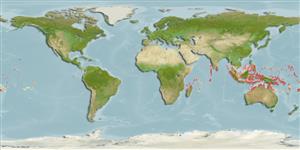>
Atheriniformes (Silversides) >
Atherinidae (Silversides) > Atherinomorinae
Etymology: Hypoatherina: Greek, hypo = under + Greek, atherina, the Greek name for the eperlane; 1770 (Ref. 45335).
Eponymy: Dr Clifford Adrian Barnes (1905-1995) was an American marine scientist who was Professor of Oceanography at the University of Washington, Seattle (1947–1973) his alma mater and Professor Emeritus after retirement. [...] (Ref. 128868), visit book page.
More on author: Schultz.
Environment: milieu / climate zone / depth range / distribution range
Ecología
marino asociado a arrecife; rango de profundidad 0 - 5 m (Ref. 86942). Tropical; 12°N - 20°S
Indo-Pacific: East Africa to the northern Cook Islands, north to New Guinea and the Marshall Islands, south to northern Australia, New Caledonia and Fiji.
Tamaño / Peso / Age
Maturity: Lm ? range ? - ? cm
Max length : 10.0 cm TL macho / no sexado; (Ref. 48635); common length : 4.0 cm TL macho / no sexado; (Ref. 2871)
Espinas dorsales (total) : 6 - 8; Radios blandos dorsales (total) : 8 - 12; Espinas anales: 1; Radios blandos anales: 12 - 17. Ascending process of premaxilla long and slender; ramus of dentary highly elevated posteriorly; midlateral band wide, broadest between anus and anal fin (Ref. 9760). First dorsal fin above middle of body; second dorsal fin originates behind the beginning of the anal fin; mid-lateral scales 40-43; transverse scales 5; predorsal scales 16-19 (Ref. 2334). Midlateral band width 2.3-3.3 in body depth (Ref. 37816).
Inhabits lagoons and along shorelines of outlying islands (Ref. 3302). During daylight, schooling fish may be periodically seen to jump out of the water to avoid predators. They are also easily attracted to light. The fish are gravid at about 4-4.5 cm SL by July in the northern hemisphere. Because of their large numbers, they are probably important as forage food for larger fishes (Ref. 9760).
Life cycle and mating behavior
Madurez | Reproducción | Puesta | Huevos | Fecundidad | Larva
Oviparous, distinct pairing during breeding (Ref. 205).
Ivantsoff, W., 1984. Atherinidae. In W. Fischer and G. Bianchi (eds.) FAO species identification sheets for fishery purposes. Western Indian Ocean fishing area 51. Vol. 1. (Ref. 3302)
IUCN Red List Status (Ref. 130435: Version 2024-1)
Threat to humans
Harmless
Human uses
Pesquerías: sin interés
Herramientas
Special reports
Download XML
Fuentes de Internet
Estimates based on models
Preferred temperature (Ref.
123201): 26.8 - 29.3, mean 28.6 °C (based on 1816 cells).
Phylogenetic diversity index (Ref.
82804): PD
50 = 0.5001 [Uniqueness, from 0.5 = low to 2.0 = high].
Bayesian length-weight: a=0.00562 (0.00240 - 0.01320), b=3.15 (2.95 - 3.35), in cm total length, based on LWR estimates for this (Sub)family-body shape (Ref.
93245).
Nivel trófico (Ref.
69278): 3.3 ±0.4 se; based on size and trophs of closest relatives
Resiliencia (Ref.
120179): Alto, población duplicada en un tiempo mínimo inferior a 15 meses (Preliminary K or Fecundity.).
Fishing Vulnerability (Ref.
59153): Low vulnerability (10 of 100).
Nutrients (Ref.
124155): Calcium = 127 [68, 248] mg/100g; Iron = 0.732 [0.406, 1.349] mg/100g; Protein = 19.5 [17.2, 21.8] %; Omega3 = 0.125 [0.054, 0.317] g/100g; Selenium = 16.1 [7.2, 38.6] μg/100g; VitaminA = 192 [57, 585] μg/100g; Zinc = 1.94 [1.27, 2.85] mg/100g (wet weight);
